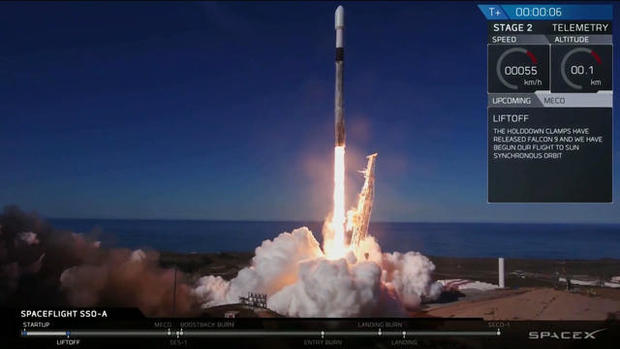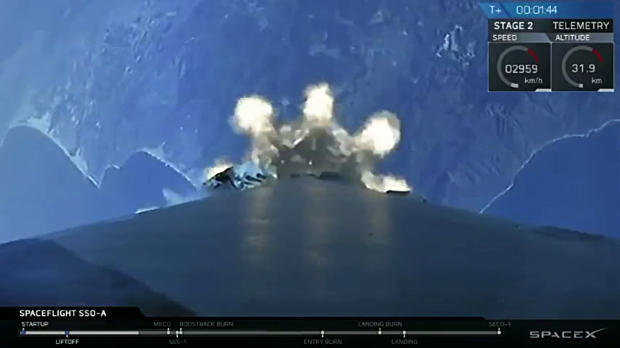SpaceX launches 64 "smallsats" in record flight
A SpaceX Falcon 9 rocket using a first stage making a record third flight vaulted away from the California coast Monday, boosting 64 small satellites into orbit for a wide variety of government, academic and private-sector users -- including artists -- in a commercial launch chartered by Seattle-based Spaceflight.
The Falcon 9's well-traveled first stage returned to Earth and safely landed on an off-shore drone ship -- the "Just Read the Instructions" -- to chalk up SpaceX's 32nd recovery of a spent booster, the first to have flown three times.
SpaceX founder Elon Musk says the new "block 5" stages are designed fly dozens of times with minimal refurbishment between launchings, a key element in the company's drive to lower launch costs by recovering and re-flying the Falcon 9's first stage.
SpaceX's recovery record now stands at 20 successful drone ship recoveries, 11 on land at the Cape Canaveral Air Force Station in Florida and one at Vandenberg Air Force Base northwest of Los Angeles. Presumably, the latest recovered stage will fly a fourth time, but SpaceX has not yet provided any details.
During the 69th International Astronautical Congress in Bremen, Germany, Oct. 3, Hans Koenigsmann, vice president of flight reliability for SpaceX, said multiple reflights will soon be the rule, not the exception.
"Beginning soon, we will start flying a booster three times, and then take it to four times, five times, an so on and so forth," he said. "We have obviously to be very careful in evaluating boosters that come back after multiple flights. We want to make sure that we don't see wear and tear in the wrong spots."
SpaceX also deployed a second recovery ship, the "Mr. Steven," equipped with a giant net to catch one or both halves of the Falcon 9's protective nose cone fairing. There was no immediate word on whether the fairing recovery was successful.
With the Vandenberg launch out of the way, SpaceX engineers at the Cape Canaveral Air Force Station in Florida made final preparations to launch a brand new Falcon 9 Tuesday to deliver 5,600 pounds of equipment, supplies and science gear to the International Space Station aboard a Dragon cargo ship making SpaceX's 16th operational supply run.
Earlier Monday, the Russian space agency Roscosmos launched a Soyuz crew ferry ship from the Baikonur Cosmodrome in Kazakhstan, carrying a veteran cosmonaut, a NASA astronaut and a Canadian flight engineer to the station. It was the first crewed flight of a Soyuz FG booster since a dramatic launch abort Oct. 11.
Monday's flight went smoothly and the crew reached the station about an hour before the Falcon 9 blasted off from Vandenberg. Assuming an on-time Dragon launch Tuesday, the station crew will welcome the cargo ship to the lab complex Thursday, using the station's robot arm to pull the spacecraft in for berthing.
Monday's Falcon 9 flight got underway at 10:34 a.m. PST when the Falcon 9's nine Merlin first stage engines ignited with a rush of flame and steaming exhaust, pushing the slender 130-foot-tall rocket away from pad 4-East at Vandenberg.
Liftoff came five days late, first because of predicted high winds and then an additional day to allow unspecified inspections of the Falcon 9's second stage. But it was clear sailing Monday with an on-time launch and a spectacular southerly climb out of the thick lower atmosphere.
The first stage shut down and fall away about two minutes and 24 seconds after liftoff. The single Merlin engine powering the second stage then ignited for a seven-and-a-half minute burn to complete the trip to a 375-mile-high orbit around Earth's poles.
The first stage, meanwhile, flipped around and re-ignited three of its engines to slow down for the plunge back into the lower atmosphere. Falling tail first, the booster used four titanium "grid fins" at the top of the rocket to maintain the proper orientation as it fell tail first toward the "Just Read The Instructions" stationed well off the coast of California.
As it neared the landing deck, a single engine was restarted, four landing legs deployed and the stage settled to a picture-perfect touchdown on the automated droneship. It will be hauled back to port, offloaded and shipped to SpaceX's Texas flight test facility for inspections and whatever refurbishment might be required.
But as always, recovering the first stage was a secondary objective. Two minutes and 15 seconds after launch, the Falcon 9's second stage reached the planned orbit and about four minutes after that, a custom deployer built by Spaceflight began releasing its multiple payloads.
Spaceflight booked the Falcon 9 to launch 64 small so-called "smallsats" provided by 34 government and private-sector companies and organizations representing 17 nations, including the U.S. Defense Department, the Earth-observation company Planet, universities and even two art museums.
One sponsored a balloon that will inflate in orbit and be visible from the ground while the other reportedly supplied a small sculpture depicting African American test pilot Robert Lawrence, who was selected as an Air Force astronaut in 1967. He was killed in a plane crash six months later.
The Falcon 9 purchased by Spaceflight was the first fully dedicated to a smallsat "rideshare" mission using a single rocket to carry dozens of spacecraft to orbit that otherwise might have difficulty finding a ride to space. While the 64 launched Monday was a U.S. record, an Indian PSLV rocket carried 104 spacecraft to orbit earlier this year.
A Spacelight statement said the Falcon 9 mission "signifies the company's first dedicated rideshare mission to a sun-synchronous low-Earth orbit. It also represents the company's purchase of an entire Falcon 9 to accommodate the growing number of domestic, international, government and commercial customers seeking affordable rideshare options to launch their spacecraft into orbit."
Monday's launching marked SpaceX's 19th flight so far this year and the company's 64th Falcon 9 launch, the 65th counting the February debut of the three-core Falcon Heavy. Thirteen of the flights so far this year used previously flown first stages.
Koenisgman said the Falcon 9's first stage, from its nine engines to its propellant tanks and plumbing, was designed with reusability in mind. To make that strategy economically viable, he said, "you've got to have the rocket recovered and reused with minimal refurbishment."
"Minimal is probably, in the beginning, more like an inspection and maintenance thing," he said. "But as you go along, there should be less and less, and you should basically learn what you see and improve the rocket at the same time."
One major concern is is fatigue.
"You've got to watch the life cycle on components," he said. "They vibrate, basically, and you've got to have an eye on fracture control and make sure that you don't have any fractures on those components. That is actually not new. Helicopters do this right now. They are basically vibration machines, and they track, actually, the number of cycles, and they know exactly when they have to go into maintenance or preventive maintenance.
"Something similar is what we can do here on the rocket. We can basically record the flight load, and then log this to the history of the part, and we can figure out when the part has to be exchanged, if it actually has to be exchanged. Ideally, you do not want to change parts."
Most of the work involved in readying a Falcon 9 first stage for another flight is making sure the rocket's engines are in sound shape.
"Most of it is actually parts that are not qualified for the next flight, so we just swap the parts," he said. "It's not actual damage. It's a preventive maintenance kind of thing, where we know this part may fail the next time, so we just don't take the risk and we swap it."
There are other issues, but overall "it's actually not that bad. In terms of refurbishment and building a new rocket, it's way cheaper to refurbish."







